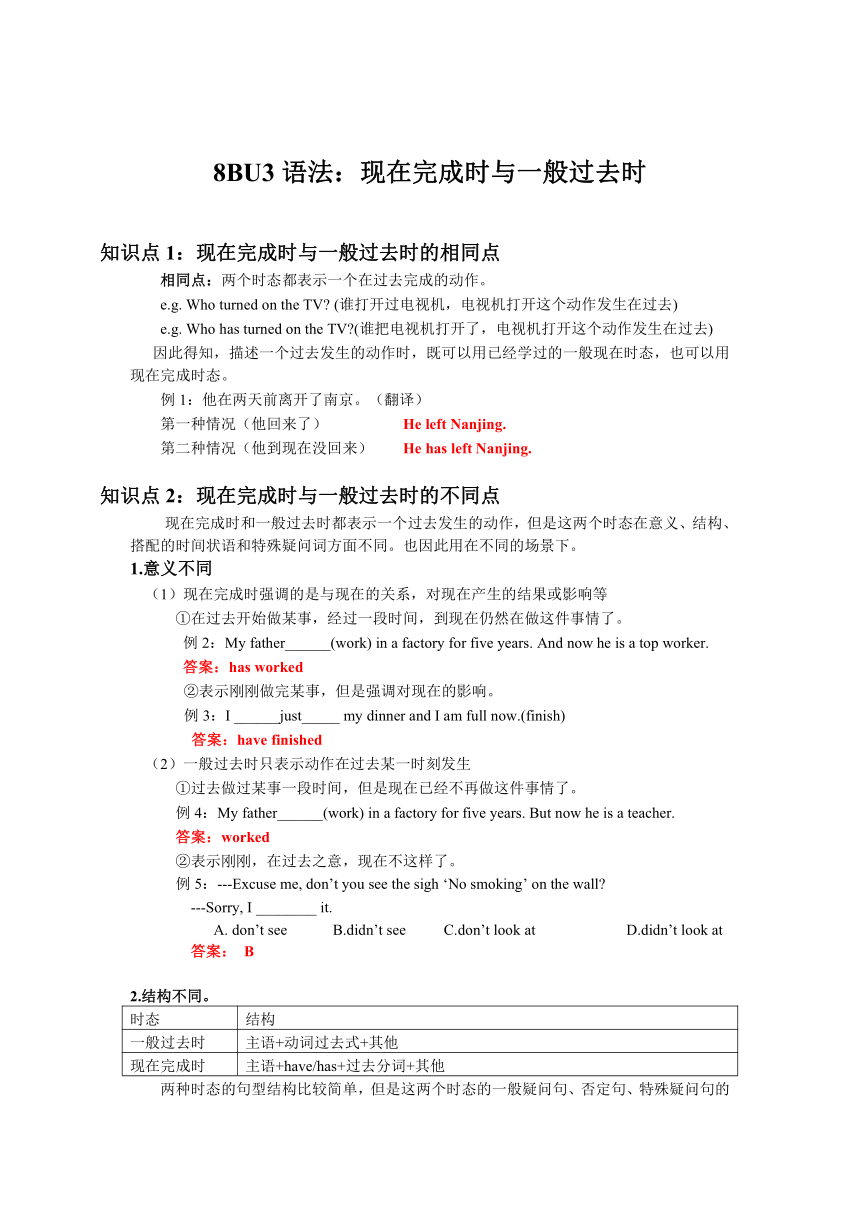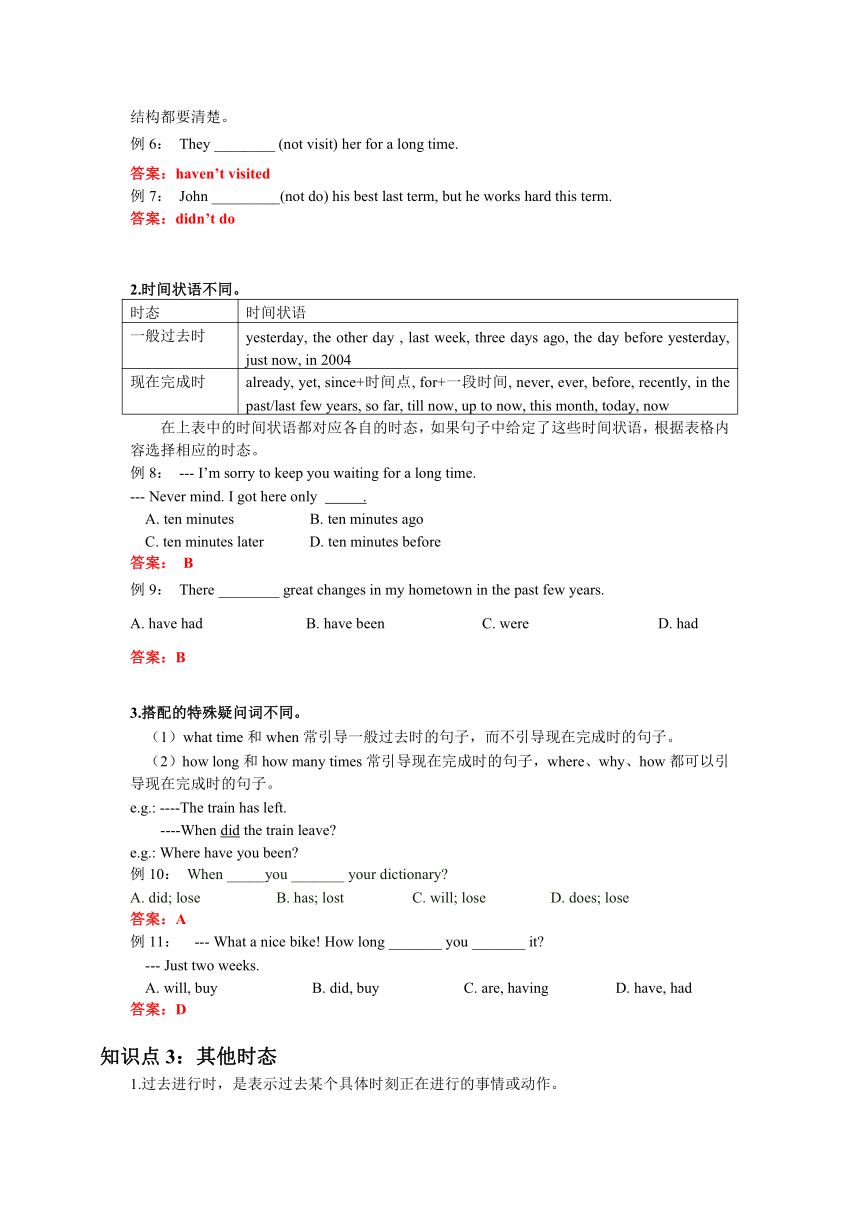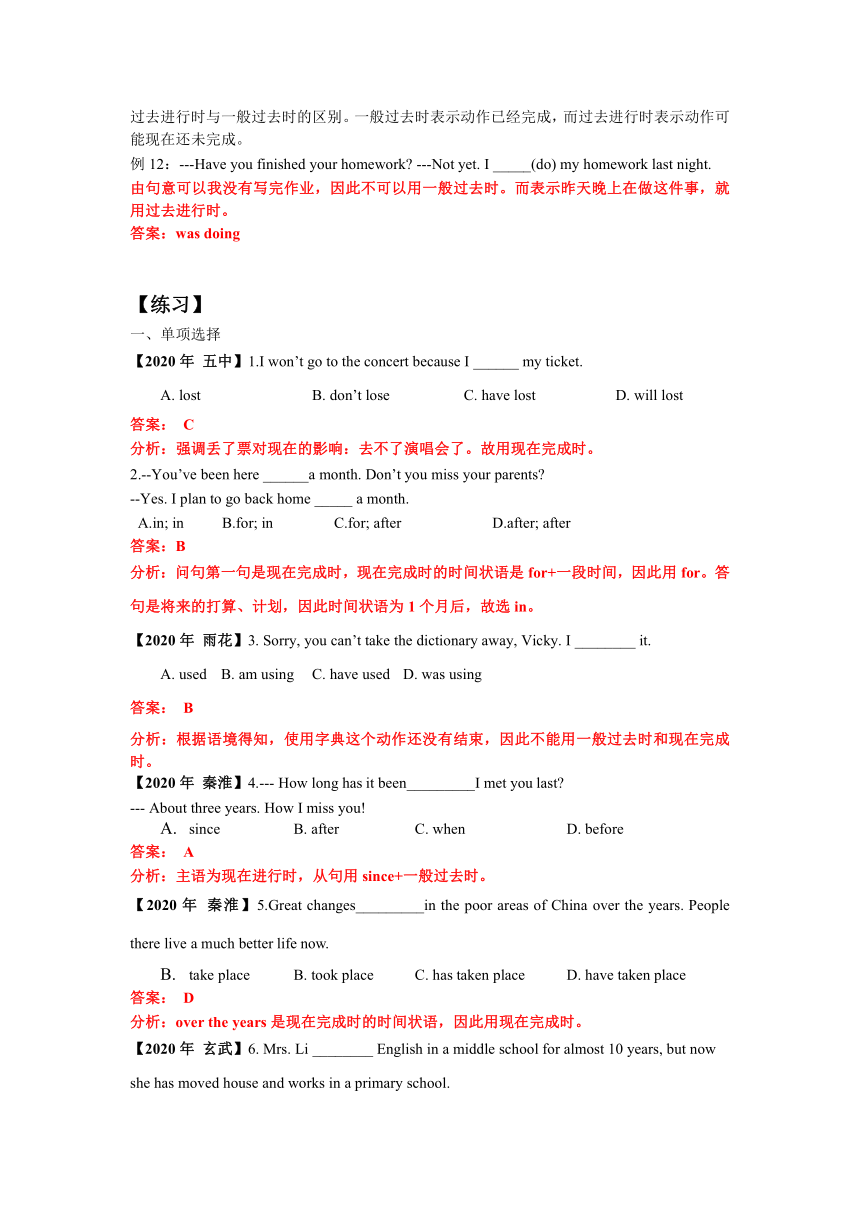牛津译林版八年级下Unit 3 Online tours语法现在完成时学案(含答案)
文档属性
| 名称 | 牛津译林版八年级下Unit 3 Online tours语法现在完成时学案(含答案) |  | |
| 格式 | zip | ||
| 文件大小 | 30.4KB | ||
| 资源类型 | 教案 | ||
| 版本资源 | 牛津译林版 | ||
| 科目 | 英语 | ||
| 更新时间 | 2022-03-19 10:53:44 | ||
图片预览



文档简介
8BU3语法:现在完成时与一般过去时
知识点1:现在完成时与一般过去时的相同点
相同点:两个时态都表示一个在过去完成的动作。
e.g. Who turned on the TV (谁打开过电视机,电视机打开这个动作发生在过去)
e.g. Who has turned on the TV (谁把电视机打开了,电视机打开这个动作发生在过去)
因此得知,描述一个过去发生的动作时,既可以用已经学过的一般现在时态,也可以用现在完成时态。
例1:他在两天前离开了南京。(翻译)
第一种情况(他回来了) He left Nanjing.
第二种情况(他到现在没回来) He has left Nanjing.
知识点2:现在完成时与一般过去时的不同点
现在完成时和一般过去时都表示一个过去发生的动作,但是这两个时态在意义、结构、搭配的时间状语和特殊疑问词方面不同。也因此用在不同的场景下。
1.意义不同
(1)现在完成时强调的是与现在的关系,对现在产生的结果或影响等
①在过去开始做某事,经过一段时间,到现在仍然在做这件事情了。
例2:My father______(work) in a factory for five years. And now he is a top worker.
答案:has worked
②表示刚刚做完某事,但是强调对现在的影响。
例3:I ______just_____ my dinner and I am full now.(finish)
答案:have finished
(2)一般过去时只表示动作在过去某一时刻发生
①过去做过某事一段时间,但是现在已经不再做这件事情了。
例4:My father______(work) in a factory for five years. But now he is a teacher.
答案:worked
②表示刚刚,在过去之意,现在不这样了。
例5:---Excuse me, don’t you see the sigh ‘No smoking’ on the wall
---Sorry, I ________ it.
A. don’t see B.didn’t see C.don’t look at D.didn’t look at
答案: B
2.结构不同。
时态 结构
一般过去时 主语+动词过去式+其他
现在完成时 主语+have/has+过去分词+其他
两种时态的句型结构比较简单,但是这两个时态的一般疑问句、否定句、特殊疑问句的结构都要清楚。
例6: They ________ (not visit) her for a long time.
答案:haven’t visited
例7: John _________(not do) his best last term, but he works hard this term.
答案:didn’t do
2.时间状语不同。
时态 时间状语
一般过去时 yesterday, the other day , last week, three days ago, the day before yesterday, just now, in 2004
现在完成时 already, yet, since+时间点, for+一段时间, never, ever, before, recently, in the past/last few years, so far, till now, up to now, this month, today, now
在上表中的时间状语都对应各自的时态,如果句子中给定了这些时间状语,根据表格内容选择相应的时态。
例8: --- I’m sorry to keep you waiting for a long time.
--- Never mind. I got here only .
A. ten minutes B. ten minutes ago
C. ten minutes later D. ten minutes before
答案: B
例9: There ________ great changes in my hometown in the past few years.
A. have had B. have been C. were D. had
答案:B
3.搭配的特殊疑问词不同。
(1)what time和when常引导一般过去时的句子,而不引导现在完成时的句子。
(2)how long和how many times常引导现在完成时的句子,where、why、how都可以引导现在完成时的句子。
e.g.: ----The train has left.
----When did the train leave
e.g.: Where have you been
例10: When _____you _______ your dictionary
A. did; lose B. has; lost C. will; lose D. does; lose
答案:A
例11: --- What a nice bike! How long _______ you _______ it
--- Just two weeks.
A. will, buy B. did, buy C. are, having D. have, had
答案:D
知识点3:其他时态
1.过去进行时,是表示过去某个具体时刻正在进行的事情或动作。
过去进行时与一般过去时的区别。一般过去时表示动作已经完成,而过去进行时表示动作可能现在还未完成。
例12:---Have you finished your homework ---Not yet. I _____(do) my homework last night.
由句意可以我没有写完作业,因此不可以用一般过去时。而表示昨天晚上在做这件事,就用过去进行时。
答案:was doing
【练习】
一、单项选择
【2020年 五中】1.I won’t go to the concert because I ______ my ticket.
A. lost B. don’t lose C. have lost D. will lost
答案: C
分析:强调丢了票对现在的影响:去不了演唱会了。故用现在完成时。
2.--You’ve been here ______a month. Don’t you miss your parents
--Yes. I plan to go back home _____ a month.
A.in; in B.for; in C.for; after D.after; after
答案:B
分析:问句第一句是现在完成时,现在完成时的时间状语是for+一段时间,因此用for。答句是将来的打算、计划,因此时间状语为1个月后,故选in。
【2020年 雨花】3. Sorry, you can’t take the dictionary away, Vicky. I ________ it.
A. used B. am using C. have used D. was using
答案: B
分析:根据语境得知,使用字典这个动作还没有结束,因此不能用一般过去时和现在完成时。
【2020年 秦淮】4.--- How long has it been_________I met you last
--- About three years. How I miss you!
since B. after C. when D. before
答案: A
分析:主语为现在进行时,从句用since+一般过去时。
【2020年 秦淮】5.Great changes_________in the poor areas of China over the years. People there live a much better life now.
take place B. took place C. has taken place D. have taken place
答案: D
分析:over the years是现在完成时的时间状语,因此用现在完成时。
【2020年 玄武】6. Mrs. Li ________ English in a middle school for almost 10 years, but now she has moved house and works in a primary school.
A. taught B. was teaching C. teaches D. has taught
答案: A
分析:根据句意可知,李老师在中学教书的情况现在发生了改变,因此用一般过去时。
7. ---When the League
---In 2011.
A. have you joined B. have you become a member of
C. have you been in D. did you join
答案: D
分析:考察一般过去时。句意:---你什么时候加入联盟的?---在2011年。根据句意可知是问加入联盟的时间,肯定是过去的时间点,与过去的时间点搭配的时态是一般过去时。因此选D。
8.--- Hello, Tom. Where is Jack now
--- Maybe he ______ to the library. But he _____ here an hour ago.
A. has gone; stayed B. has been; stayed C. has been; has stayed D. went; has stayed
答案: A
分析:考察现在完成时的用法。句意为:---你好啊,汤姆。杰克现在在哪里?---他可能去了图书馆。但是他是一个小时前待在那里的。D项,由于问句问的是杰克现在在哪里?答句就变成了他过去去了图书馆,问答两句时间不一致,造成答非所问。所以排除D。have gone to与have been to的区别在于have gone to表示去了未回来,而have been to表示去了回来了。根据句意可知杰克还没有回来,所以排除B、C。故选A。
9.No man knows what potential (潜力) he has till he ______very hard to be good.
A.tried B.will try C.is trying D.has tried
答案:D
分析:用现在完成时代替一般现在时更有内涵。
10. ---Uncle Sam, I have to leave right now.
---What a pity! I you could stay a little longer with us.
A. thought B. think C. am thinking D. have thought
答案:A
分析:根据句意可知我过去/刚刚认为你可以和我们多呆一会,但现在不这样认为了。因此选A。
11.---When _____you _______the new bike
---Well, I _____it for half a year.
A.did, buy; have bought B.have, bought; have had
C.have, kept; have had D.did, buy; have had
答案:D
分析:问句特殊疑问词为when,故该句为一般过去时;答句时间状语为for half a year,故该句为现在完成时,且需要用延续性动词。
12.How nice the cake_____!--Help yourself. I hope you will like it.
smells B.is smelling C.smelled D.has smelled
答案:A
分析:感官动词一般不用进行时态,故因此选A。
13.He’s never been to Thailand, ______
A.has he B. hasn’t he C.is he D.isn’t he
答案:A
分析:主句带有否定词never、little、few、no等时,主句相当于否定句,而反义疑问句用肯定形式。
14.---He hasn’t watched the movie Wu Shuang, has he
---_______. he told me it was very moving (感人的) and interesting. He’d like to watch it again.
A.Yes, he has B.Yes, he hasn’t C.No, he hasn’t D.No, he has.
答案:A
分析:考察答句可知他看过这部电影,因此回答Yes,he has.
15.---When _____your mother _____ her hometown
---She _______since 20 years ago.
A.has, left; has left B.did, leave; has left
C.did, leave; has been away D.has, left; has been away
答案:C
分析:问句特殊疑问词为when,故该句为一般过去时;答句时间状语为since 20 years ago,故该句为现在完成时,且需要用延续性动词。
二、词形填空
【2020年 鼓楼】56.The child __________(eat) up all he food on the plate. Now there isn't anything on it.
答案:has eaten
分析:考察过去发生的动作对现在的影响,用现在完成时。
【2020年 五中】There ________ (be) many changes in this small town in the past ten years.
答案:have been
分析:时间状语为in the past ten years,用现在完成时。
【2020年 鼓楼】45. After watching the documentary “Amazing China”, you will surely understand that there _____ (be) great changes in China in the past 40 years.
答案:have been
分析:时间状语为in the past 40 years,用现在完成时。
4.Look! The snow ______(stop). Why not go out to make a snowman
答案:has stopped
分析:学生写成了has been over。错误在于这里强调现在不下雪了,而不强调雪停下来多久。因此不需要用延续性的动词,直接用has stopped就可以了。很多学生学习了延续性动词之后,就会在任何时候都把短暂性动词改成延续性动词,这是不正确的。过去发生的动作对现在有影响,动词可以是短暂性动词。
5.— Why didn’t you watch the wonderful show last night
— Oh, I __________(chat) on WeChat with my friends at that time and forgot all about that.
答案:was chatting
分析:由时间状语at that time可知用过去进行时。
三、句型
1.自从来到无锡,我们的外教已经习惯了这里的生活。
The foreign teacher in our school ______________________________________here since he came to Wuxi.
答案:has been used to living
分析:since+一般过去时的句子表示一段时间,因此需要与延续性动词搭配。学生做选择题往往能考虑到这一点,但是写句子时往往只能想到现在完成时,延续性这一点往往被忽略掉。
2.电视机应该开了几个小时了。请把它关掉,好吗?
___________________________________________. Would you please turn it off
答案:The TV has been on for several hours.
分析:学生写成了The TV has already opened for several hours. 首先是打开电视和打开门这两个打开不一样,前一个是turn on,后一个是open。另外,turn on的延续性动词是be on,而open的延续性动词为be open。
3.--那个会议结束多久了?---将近半小时。
---How long _______________________ ---For _______________
答案:has the meeting been over; nearly half an hour.
分析:学生写成了has the meeting overed; nearly half an hour。结束的延续性动词是be over。
14.自从他儿子搬走后,这个老人一直感觉很孤单。
The old man ______________________________since his son moved away.
答案:has felt lonely
分析:时间状语为since+一般过去时句子,故主语用现在完成时。
15.政府已经采取行动阻止这些工厂向河里倾倒废物了。
The government ___________________________________________________the river.
答案:has already taken action to prevent these factories from pouring waste into
分析:根据中文“已经采取行动”可知用现在完成时。
35.自从她离开香港后,我们彼此就没联系了。
Since she left Hong Kong, we ______________________________________.
答案:have been out of reach
分析:lose touch的延续性动词为be out of touch
49.自20世纪以来,人们已习惯了聚集在这里来欢迎新年的到来。
Since the 20th century, ____________________________________to welcome the new year.
答案:people have been used to gathering here
分析:学生写成people have got used to gathering here。因为前面有since引导的时间状语,表示20世纪到现在的一段时间,因此后面的动作必须要是延续性的。
知识点1:现在完成时与一般过去时的相同点
相同点:两个时态都表示一个在过去完成的动作。
e.g. Who turned on the TV (谁打开过电视机,电视机打开这个动作发生在过去)
e.g. Who has turned on the TV (谁把电视机打开了,电视机打开这个动作发生在过去)
因此得知,描述一个过去发生的动作时,既可以用已经学过的一般现在时态,也可以用现在完成时态。
例1:他在两天前离开了南京。(翻译)
第一种情况(他回来了) He left Nanjing.
第二种情况(他到现在没回来) He has left Nanjing.
知识点2:现在完成时与一般过去时的不同点
现在完成时和一般过去时都表示一个过去发生的动作,但是这两个时态在意义、结构、搭配的时间状语和特殊疑问词方面不同。也因此用在不同的场景下。
1.意义不同
(1)现在完成时强调的是与现在的关系,对现在产生的结果或影响等
①在过去开始做某事,经过一段时间,到现在仍然在做这件事情了。
例2:My father______(work) in a factory for five years. And now he is a top worker.
答案:has worked
②表示刚刚做完某事,但是强调对现在的影响。
例3:I ______just_____ my dinner and I am full now.(finish)
答案:have finished
(2)一般过去时只表示动作在过去某一时刻发生
①过去做过某事一段时间,但是现在已经不再做这件事情了。
例4:My father______(work) in a factory for five years. But now he is a teacher.
答案:worked
②表示刚刚,在过去之意,现在不这样了。
例5:---Excuse me, don’t you see the sigh ‘No smoking’ on the wall
---Sorry, I ________ it.
A. don’t see B.didn’t see C.don’t look at D.didn’t look at
答案: B
2.结构不同。
时态 结构
一般过去时 主语+动词过去式+其他
现在完成时 主语+have/has+过去分词+其他
两种时态的句型结构比较简单,但是这两个时态的一般疑问句、否定句、特殊疑问句的结构都要清楚。
例6: They ________ (not visit) her for a long time.
答案:haven’t visited
例7: John _________(not do) his best last term, but he works hard this term.
答案:didn’t do
2.时间状语不同。
时态 时间状语
一般过去时 yesterday, the other day , last week, three days ago, the day before yesterday, just now, in 2004
现在完成时 already, yet, since+时间点, for+一段时间, never, ever, before, recently, in the past/last few years, so far, till now, up to now, this month, today, now
在上表中的时间状语都对应各自的时态,如果句子中给定了这些时间状语,根据表格内容选择相应的时态。
例8: --- I’m sorry to keep you waiting for a long time.
--- Never mind. I got here only .
A. ten minutes B. ten minutes ago
C. ten minutes later D. ten minutes before
答案: B
例9: There ________ great changes in my hometown in the past few years.
A. have had B. have been C. were D. had
答案:B
3.搭配的特殊疑问词不同。
(1)what time和when常引导一般过去时的句子,而不引导现在完成时的句子。
(2)how long和how many times常引导现在完成时的句子,where、why、how都可以引导现在完成时的句子。
e.g.: ----The train has left.
----When did the train leave
e.g.: Where have you been
例10: When _____you _______ your dictionary
A. did; lose B. has; lost C. will; lose D. does; lose
答案:A
例11: --- What a nice bike! How long _______ you _______ it
--- Just two weeks.
A. will, buy B. did, buy C. are, having D. have, had
答案:D
知识点3:其他时态
1.过去进行时,是表示过去某个具体时刻正在进行的事情或动作。
过去进行时与一般过去时的区别。一般过去时表示动作已经完成,而过去进行时表示动作可能现在还未完成。
例12:---Have you finished your homework ---Not yet. I _____(do) my homework last night.
由句意可以我没有写完作业,因此不可以用一般过去时。而表示昨天晚上在做这件事,就用过去进行时。
答案:was doing
【练习】
一、单项选择
【2020年 五中】1.I won’t go to the concert because I ______ my ticket.
A. lost B. don’t lose C. have lost D. will lost
答案: C
分析:强调丢了票对现在的影响:去不了演唱会了。故用现在完成时。
2.--You’ve been here ______a month. Don’t you miss your parents
--Yes. I plan to go back home _____ a month.
A.in; in B.for; in C.for; after D.after; after
答案:B
分析:问句第一句是现在完成时,现在完成时的时间状语是for+一段时间,因此用for。答句是将来的打算、计划,因此时间状语为1个月后,故选in。
【2020年 雨花】3. Sorry, you can’t take the dictionary away, Vicky. I ________ it.
A. used B. am using C. have used D. was using
答案: B
分析:根据语境得知,使用字典这个动作还没有结束,因此不能用一般过去时和现在完成时。
【2020年 秦淮】4.--- How long has it been_________I met you last
--- About three years. How I miss you!
since B. after C. when D. before
答案: A
分析:主语为现在进行时,从句用since+一般过去时。
【2020年 秦淮】5.Great changes_________in the poor areas of China over the years. People there live a much better life now.
take place B. took place C. has taken place D. have taken place
答案: D
分析:over the years是现在完成时的时间状语,因此用现在完成时。
【2020年 玄武】6. Mrs. Li ________ English in a middle school for almost 10 years, but now she has moved house and works in a primary school.
A. taught B. was teaching C. teaches D. has taught
答案: A
分析:根据句意可知,李老师在中学教书的情况现在发生了改变,因此用一般过去时。
7. ---When the League
---In 2011.
A. have you joined B. have you become a member of
C. have you been in D. did you join
答案: D
分析:考察一般过去时。句意:---你什么时候加入联盟的?---在2011年。根据句意可知是问加入联盟的时间,肯定是过去的时间点,与过去的时间点搭配的时态是一般过去时。因此选D。
8.--- Hello, Tom. Where is Jack now
--- Maybe he ______ to the library. But he _____ here an hour ago.
A. has gone; stayed B. has been; stayed C. has been; has stayed D. went; has stayed
答案: A
分析:考察现在完成时的用法。句意为:---你好啊,汤姆。杰克现在在哪里?---他可能去了图书馆。但是他是一个小时前待在那里的。D项,由于问句问的是杰克现在在哪里?答句就变成了他过去去了图书馆,问答两句时间不一致,造成答非所问。所以排除D。have gone to与have been to的区别在于have gone to表示去了未回来,而have been to表示去了回来了。根据句意可知杰克还没有回来,所以排除B、C。故选A。
9.No man knows what potential (潜力) he has till he ______very hard to be good.
A.tried B.will try C.is trying D.has tried
答案:D
分析:用现在完成时代替一般现在时更有内涵。
10. ---Uncle Sam, I have to leave right now.
---What a pity! I you could stay a little longer with us.
A. thought B. think C. am thinking D. have thought
答案:A
分析:根据句意可知我过去/刚刚认为你可以和我们多呆一会,但现在不这样认为了。因此选A。
11.---When _____you _______the new bike
---Well, I _____it for half a year.
A.did, buy; have bought B.have, bought; have had
C.have, kept; have had D.did, buy; have had
答案:D
分析:问句特殊疑问词为when,故该句为一般过去时;答句时间状语为for half a year,故该句为现在完成时,且需要用延续性动词。
12.How nice the cake_____!--Help yourself. I hope you will like it.
smells B.is smelling C.smelled D.has smelled
答案:A
分析:感官动词一般不用进行时态,故因此选A。
13.He’s never been to Thailand, ______
A.has he B. hasn’t he C.is he D.isn’t he
答案:A
分析:主句带有否定词never、little、few、no等时,主句相当于否定句,而反义疑问句用肯定形式。
14.---He hasn’t watched the movie Wu Shuang, has he
---_______. he told me it was very moving (感人的) and interesting. He’d like to watch it again.
A.Yes, he has B.Yes, he hasn’t C.No, he hasn’t D.No, he has.
答案:A
分析:考察答句可知他看过这部电影,因此回答Yes,he has.
15.---When _____your mother _____ her hometown
---She _______since 20 years ago.
A.has, left; has left B.did, leave; has left
C.did, leave; has been away D.has, left; has been away
答案:C
分析:问句特殊疑问词为when,故该句为一般过去时;答句时间状语为since 20 years ago,故该句为现在完成时,且需要用延续性动词。
二、词形填空
【2020年 鼓楼】56.The child __________(eat) up all he food on the plate. Now there isn't anything on it.
答案:has eaten
分析:考察过去发生的动作对现在的影响,用现在完成时。
【2020年 五中】There ________ (be) many changes in this small town in the past ten years.
答案:have been
分析:时间状语为in the past ten years,用现在完成时。
【2020年 鼓楼】45. After watching the documentary “Amazing China”, you will surely understand that there _____ (be) great changes in China in the past 40 years.
答案:have been
分析:时间状语为in the past 40 years,用现在完成时。
4.Look! The snow ______(stop). Why not go out to make a snowman
答案:has stopped
分析:学生写成了has been over。错误在于这里强调现在不下雪了,而不强调雪停下来多久。因此不需要用延续性的动词,直接用has stopped就可以了。很多学生学习了延续性动词之后,就会在任何时候都把短暂性动词改成延续性动词,这是不正确的。过去发生的动作对现在有影响,动词可以是短暂性动词。
5.— Why didn’t you watch the wonderful show last night
— Oh, I __________(chat) on WeChat with my friends at that time and forgot all about that.
答案:was chatting
分析:由时间状语at that time可知用过去进行时。
三、句型
1.自从来到无锡,我们的外教已经习惯了这里的生活。
The foreign teacher in our school ______________________________________here since he came to Wuxi.
答案:has been used to living
分析:since+一般过去时的句子表示一段时间,因此需要与延续性动词搭配。学生做选择题往往能考虑到这一点,但是写句子时往往只能想到现在完成时,延续性这一点往往被忽略掉。
2.电视机应该开了几个小时了。请把它关掉,好吗?
___________________________________________. Would you please turn it off
答案:The TV has been on for several hours.
分析:学生写成了The TV has already opened for several hours. 首先是打开电视和打开门这两个打开不一样,前一个是turn on,后一个是open。另外,turn on的延续性动词是be on,而open的延续性动词为be open。
3.--那个会议结束多久了?---将近半小时。
---How long _______________________ ---For _______________
答案:has the meeting been over; nearly half an hour.
分析:学生写成了has the meeting overed; nearly half an hour。结束的延续性动词是be over。
14.自从他儿子搬走后,这个老人一直感觉很孤单。
The old man ______________________________since his son moved away.
答案:has felt lonely
分析:时间状语为since+一般过去时句子,故主语用现在完成时。
15.政府已经采取行动阻止这些工厂向河里倾倒废物了。
The government ___________________________________________________the river.
答案:has already taken action to prevent these factories from pouring waste into
分析:根据中文“已经采取行动”可知用现在完成时。
35.自从她离开香港后,我们彼此就没联系了。
Since she left Hong Kong, we ______________________________________.
答案:have been out of reach
分析:lose touch的延续性动词为be out of touch
49.自20世纪以来,人们已习惯了聚集在这里来欢迎新年的到来。
Since the 20th century, ____________________________________to welcome the new year.
答案:people have been used to gathering here
分析:学生写成people have got used to gathering here。因为前面有since引导的时间状语,表示20世纪到现在的一段时间,因此后面的动作必须要是延续性的。
